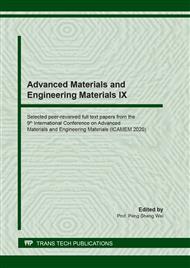[1]
J. T. Rotruck, A. L. Pope, H. E. Ganther, A. B. Swanson, D. G. Hafeman , W. G Hoekstra, Selenium: biochemical role as a component of glutathione peroxidasec. Nutrition Reviews, 1980.38(8), 280-283.
DOI: 10.1111/j.1753-4887.1980.tb05961.x
Google Scholar
[2]
C. Jacob, G. I. Giles, N. M. Giles, H. Sies, Sulfur and selenium: the role of oxidation state in protein structure and function.. Angewandte Chemie International Edition, 2003, 42(39): 4742-4758.
DOI: 10.1002/anie.200300573
Google Scholar
[3]
Baker, Monya. Whole-animal imaging: The whole picture. Nature, 2010, 463, 977-980.
Google Scholar
[4]
F.P. Kong, B. Hu, Y. Gao, X.H. Pan,, F. Huang, Q. Zheng, H. Chen, B. Tang, Fluorescence imaging of selenol in HepG2 cell apoptosis induced by Na2SeO3, Chem. Commun. 2015, 51, 3102-3105.
DOI: 10.1039/c4cc06359g
Google Scholar
[5]
B. Hu, R. R. Cheng, X. Gao, X.H. Pan, F. P. Kong, K. H. Xu and B. Tang, Targetable mesoporous silica nanoprobes for mapping the subcellular distribution of H2Se in cancer cells. Appl. Mater. Interfaces 2018. 10, 20, 17345-17351.
DOI: 10.1021/acsami.8b02206
Google Scholar
[6]
F. P. Kong, Y. H. Zhao, Z. Y. Liang, X. J., X. H. Pan, D. R. Luan, K. H. Xu, and B. Tang. A Highly Selective Fluorescent Probe for Imaging H2Se in Living cells and in vivo Based on the Disulfide Bond, Analytical Chemistry. 89(1):688-693.
DOI: 10.1021/acs.analchem.6b03136
Google Scholar
[7]
H. Maeda, K. Katayama, H. Matsuno, T. Uno. 3'-(2,4-Dinitrobenzenesulfonyl) -2',7'-dimethyl-fluorescein as a fluorescent probe for selenols. Angew. Chem. Int. Ed. 2006, 45, 1810-1813.
DOI: 10.1002/anie.200504299
Google Scholar
[8]
Y. X. Nan, W. J. Zhao, X.H. Xu, C. T. Au, R.H. Qiu, Synthesis, characterization and applications of selenocysteine responsive nanoprobe based on dinitrobenzene sulfonyl-modified poly(carbonate)s micelles. RSC Advances.2015, 5(85), 69299-69306.
DOI: 10.1039/c5ra12314c
Google Scholar
[9]
B. X. Zhang, C. P. Ge, J. Yao, Y. P. Liu, H.C. Xie, and J.G. Fang, Selective selenol fluorescent probes: design, synthesis, structural determinants, and biological applications. J. Am. Chem. Soc. 2015, 137, 757-769.
DOI: 10.1021/ja5099676
Google Scholar
[10]
C. G. Dai, J.L. Wang, Q. H. Song, Red fluorescent probes based on a BODIPY analogue for selective and sensitive detection of selenols in solutions and in living systems. J. Mater. Chem. B.2016,4, 6726-6733.
DOI: 10.1039/c6tb02081j
Google Scholar
[11]
Q. Sun, S. H. Yang, L. Wu, Q.J. Dong, W. C. Yang, and G. F. Yang, Detection of intracellular selenol-containing molecules using a fluorescent probe with near-zero background signal, Anal. Chem. 2016,88, 6084-6091.
DOI: 10.1021/acs.analchem.6b01545
Google Scholar
[12]
Q. Wang, S. R. Zhang, Y.G. Zhong, X. F. Yang, Z. Li, and H. Li, Preparation of yellow-green-emissive carbon dots and their application in constructing a fluorescent turn-on nanoprobe for Imaging of selenol in living cells. Anal. Chem. 2017, 89, 1734−1741.
DOI: 10.1021/acs.analchem.6b03983
Google Scholar


